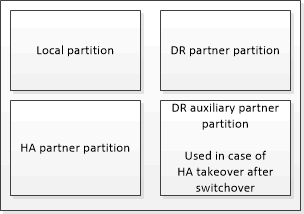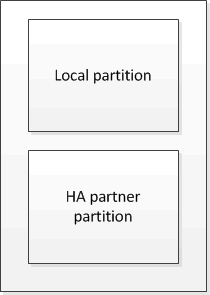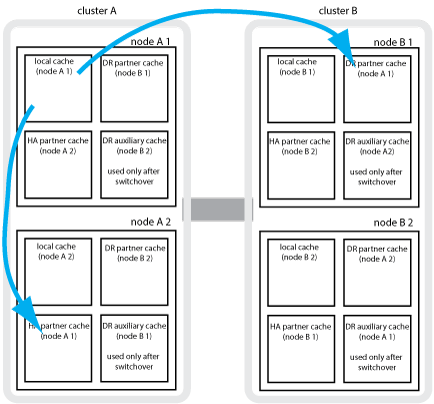How NVRAM or NVMEM cache mirroring and dynamic mirroring work in MetroCluster configurations
The nonvolatile memory (NVRAM or NVMEM, depending on the platform model) in the storage controllers is mirrored both locally to a local HA partner and remotely to a remote disaster recovery (DR) partner on the partner site. In the event of a local failover or switchover, this configuration enables data in the nonvolatile cache to be preserved.
In an HA pair that is not part of a MetroCluster configuration, each storage controller maintains two nonvolatile cache partitions: one for itself and one for its HA partner.
In a four-node MetroCluster configuration, the nonvolatile cache of each storage controller is divided into four partitions.
| Nonvolatile caches for a storage controller | |
|---|---|
| In a MetroCluster configuration | In a non-MetroCluster HA pair |
 |  |
The nonvolatile caches store the following content:
The local partition holds data that the storage controller has not yet written to disk.
The HA partner partition holds a copy of the local cache of the storage controller's HA partner.
The DR partner partition holds a copy of the local cache of the storage controller's DR partner.
The DR partner is a node in the partner cluster that is paired with the local node.
The DR auxiliary partner partition holds a copy of the local cache of the storage controller's DR auxiliary partner.
The DR auxiliary partner is the HA partner of the local node's DR partner. This cache is needed if there is an HA takeover (either when the configuration is in normal operation or after a MetroCluster switchover).
For example, the local cache of a node (node_A_1) is mirrored both locally and remotely at the MetroCluster sites. The following illustration shows that the local cache of node_A_1 is mirrored to the HA partner (node_A_2) and DR partner (node_B_1):

Dynamic mirroring in event of a local HA takeover
If a local HA takeover occurs in a four-node MetroCluster configuration, the taken-over node can no longer act as a mirror for its DR partner. To allow DR mirroring to continue, the mirroring automatically switches to the DR auxiliary partner. After a successful giveback, mirroring automatically returns to the DR partner.
For example, node_B_1 fails and is taken over by node_B_2. The local cache of node_A_1 can no longer be mirrored to node_B_1. The mirroring switches to the DR auxiliary partner, node_B_2.
